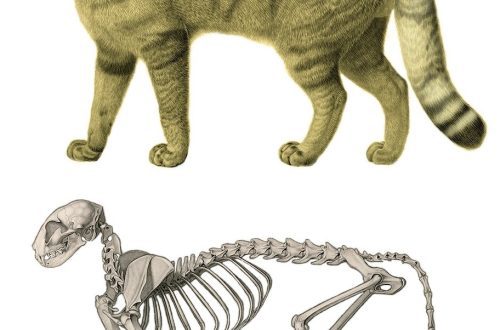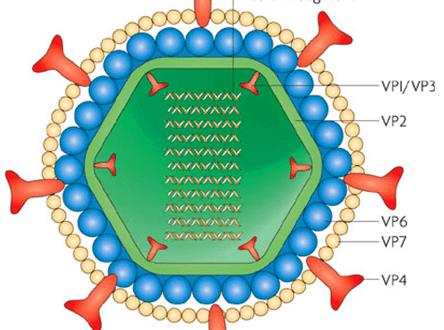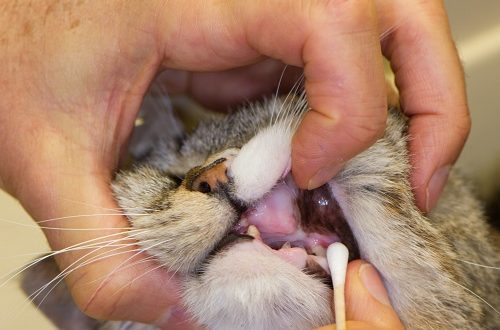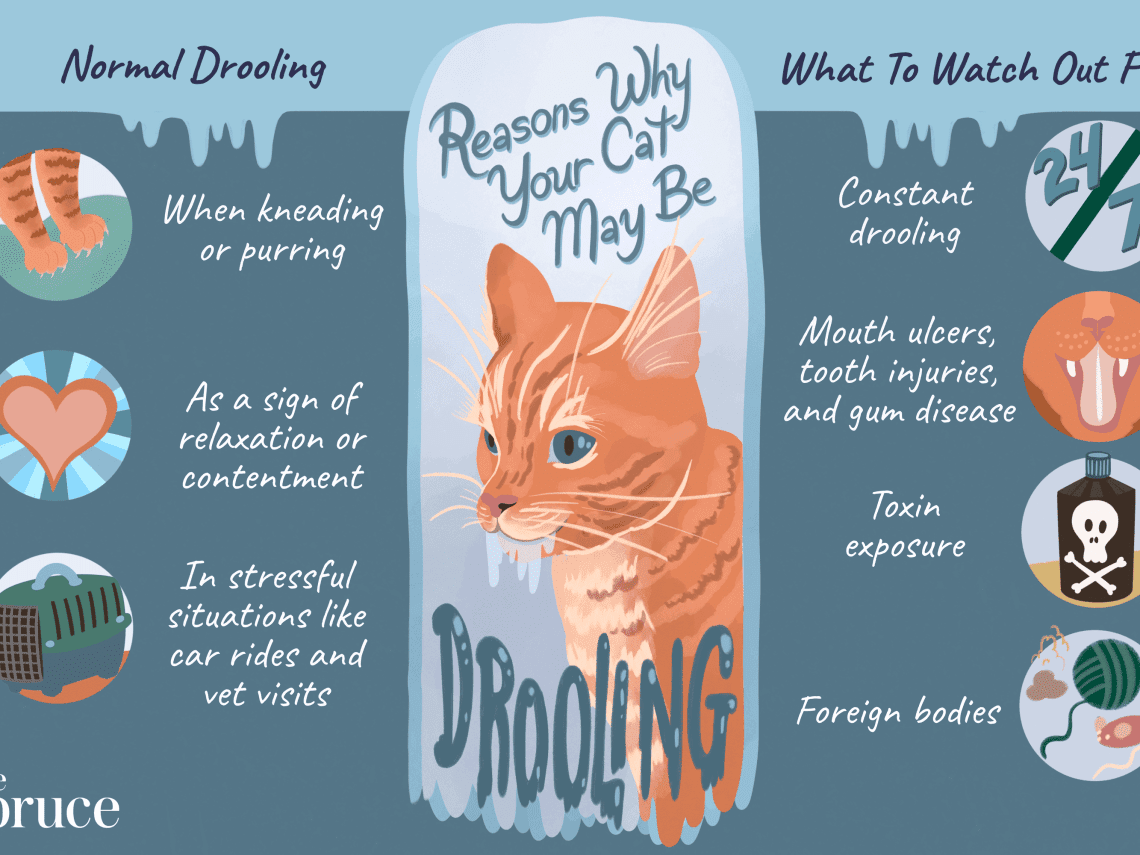
The cat is drooling from the mouth: why and what to do?
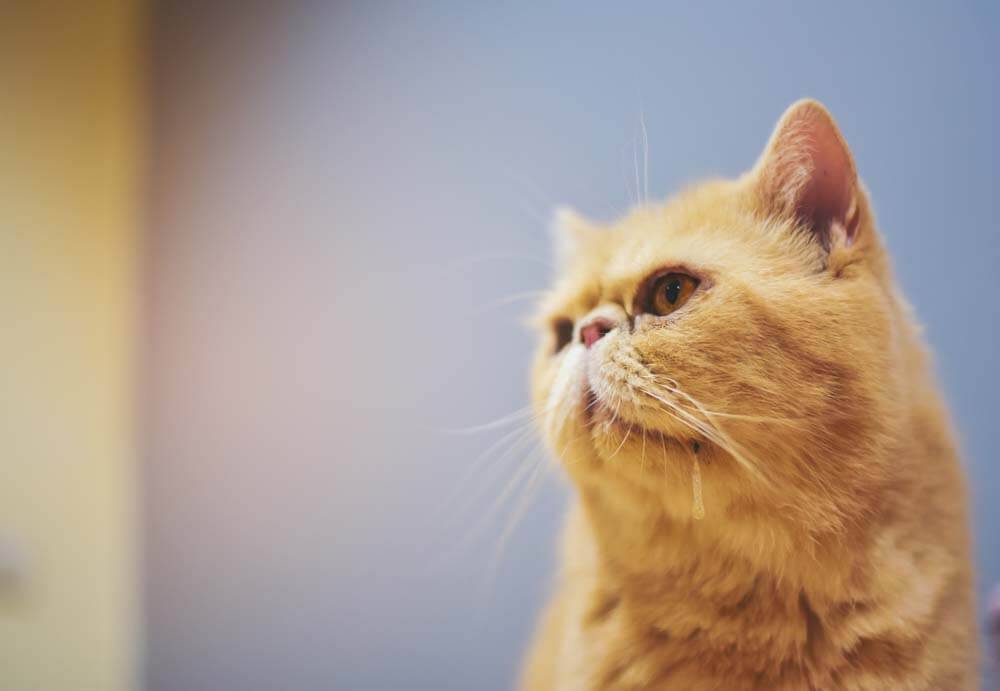
Contents
11 reasons why cats drool
Saliva is a special, complex in composition and mucous in consistency, a liquid that performs many functions: it is involved in digestion, has an antibacterial effect, and also helps the cat in self-care.
Saliva is not released in the same amount. During sleep, its production decreases, while eating it increases. Excessive salivation – hypersalivation – can be a symptom of various pathologies.
Dental diseases
Perhaps this is one of the most common reasons why a cat drools from its mouth. There are many of them: tartar, gingivitis, periodontitis, pulpitis, etc. But they all lead to pain and discomfort, which is why salivation occurs. It can be periodic or constant, sometimes saliva leaks even in a dream.

Inflammatory processes in the oral cavity
Another source of why a cat drools is inflammation in the oral cavity: ulcers, erosions, tumors.
Inflammatory processes are different:
Calcivirus is a viral disease of cats that causes painful sores in the mouth, mainly on the tongue.
Gingivostomatitis is a chronic inflammation that affects not only the gums, but also the mucous membranes of the cheeks, the caudal part of the mouth, and sometimes the pharynx and palate.
The eosinophilic granuloma complex is a manifestation of an allergic reaction in the form of erosions – local inflammations that can also appear in the oral cavity.
Burns. Thermal mouth burns in cats are quite rare. Chemicals are possible when licking caustic substances, for example, those contained in household chemicals.
Erosions and ulcers against the background of uremic stomatitis in chronic kidney disease.
Neoplasms. They are more common in older and older cats. They can be located not only on the mucous membrane of the cheeks, but also under the tongue, in the sky, in the pharynx.
Bitter or unpleasant taste
Perhaps every owner who has tried to give a pet medicine by mouth has encountered excessive salivation. Because of the bitter or unpleasant taste, the cat often drools from the mouth.
In addition to drugs, the cause of current saliva can be house plants, spices in food, insects and any unpleasant-tasting substances with which the cat has somehow come into contact: she lay down on them, sat down, stepped on them with her paw or lightly touched her tail, and then licked herself off.
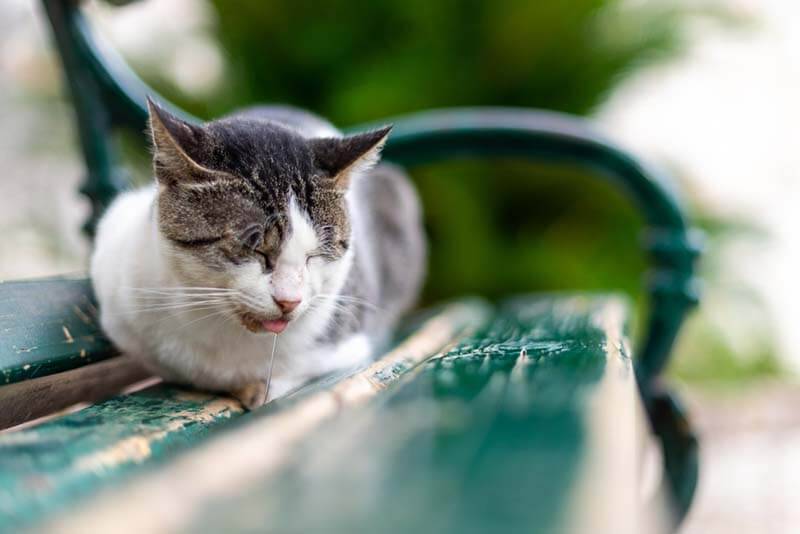
Injuries
A broken tooth, damage to the jaw, tongue, or palate is another reason for a cat to drool.
High-altitude injuries in the warm season against the background of open windows are not uncommon. And even falling from a small height is dangerous.
In the conditions of an apartment or house, cats can also be injured. This is due to their curiosity and natural desire to look for higher places in the house for a better view.
Toxins
Toxins are found in household chemicals, repair products, house plants, insecticides, fertilizers, medicines. Some veterinary products can be toxic to cats, such as those designed to treat dogs for fleas and ticks and contain permethrin.
Nausea
There are many reasons for nausea in cats: diseases of the gastrointestinal tract, genitourinary system, pancreatitis, infections, motion sickness in transport. Some cats drool quite heavily when they are sick.
Foreign body
Due to a foreign body in the oral cavity, the cat also drools. Animals can get them while playing (needles, paper clips, fishhooks, buttons) or by eating fish or birds with bones.
Sharp foreign bodies can get stuck in the cheeks, gums, between the teeth, under the tongue, in the tongue, palate, and also in the throat.
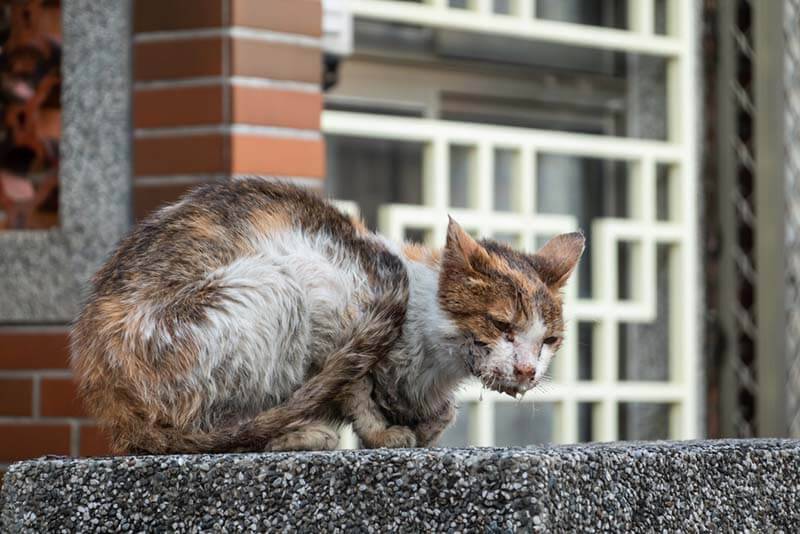
Hepatobiliary system diseases
In severe diseases of the hepatobiliary system (liver and biliary tract) – hepatitis, cholangiohepatitis, cirrhosis, portovascular shunt – a large amount of toxins enter the animal’s blood, because the liver is the most important filter of the body. Against the background of intoxication, a cat often develops profuse salivation.
Pulmonary edema
This severe, life-threatening condition can accompany diseases of the heart and respiratory tract. With pulmonary edema, a cat drools against the background of shortness of breath, forced mouth breathing and severe stress due to lack of oxygen.
Neurological pathologies
Increased salivation can accompany neurological diseases in a cat. Damage to the brain, cranial nerves, muscle paralysis can lead to a violation of the act of swallowing, opening and closing the mouth. Some pathologies are accompanied by convulsions, in which profuse frothy salivation is also often noted.
One of the diseases that can lead to such symptoms is rabies. It is deadly to animals and humans.
Behavioral and individual characteristics
Sometimes salivation in a cat is a variant of the norm and an individual feature. Some pets may drool in pleasure, stress, or the smell and sight of food. Sometimes hypersalivation can be provoked by a strong odor that is attractive to the cat, such as the smell of catnip.
There are also drugs that can cause a cat to salivate excessively, for example, after an injection of metamizole (analgin).

Concomitant symptoms
Dental pathologies and inflammatory processes are often accompanied by bad breath. Another common symptom in such diseases is pain: the cat may eat less and will prefer wet and liquid food.
Also, the coat becomes more untidy, sloppy in appearance, because. the animal stops licking.
With calcivirosis in cats, the body temperature rises, the animal becomes lethargic, refuses to feed, drinks less.
With serious injuries (dislocation and fracture of the jaw), a violation of the symmetry of the muzzle appears, sometimes the cat cannot open and close its mouth.
A foreign body can manifest itself in different ways: rubbing the muzzle with a paw, frequent licking, coughing, retching, refusing to eat, anxiety.
Nausea is often accompanied by vomiting and gagging, refusal of food and water.
With liver diseases, jaundice develops – staining of the skin and mucous membranes of the animal in yellow. Also possible: refusal to feed, depression, fever, vomiting, diarrhea.
With pulmonary edema, the animal may be restless, meow loudly, lie on its stomach with its paws tucked in, and breathe heavily and often. In severe respiratory failure, the mucous membranes of cats become cyanotic.
Neurological diseases can be accompanied by depression, behavioral changes, loss of coordination, loss of consciousness, convulsions.
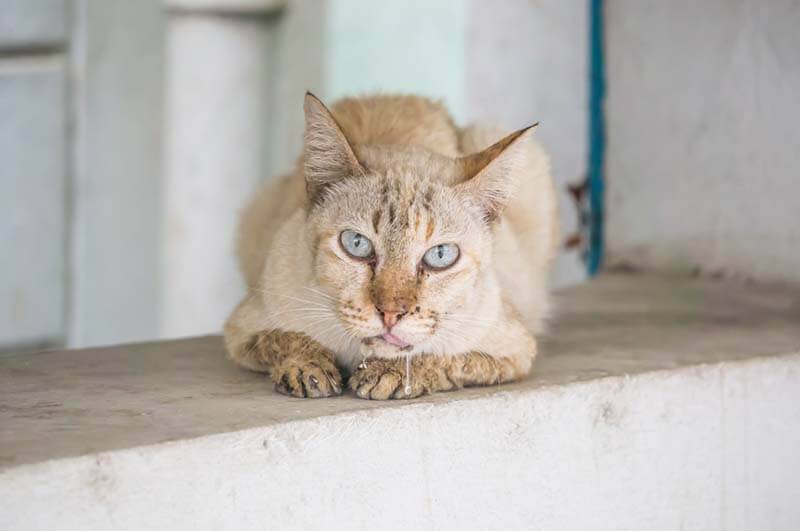
Diagnosis of Causes of Hypersalivation in Cats
Perhaps one of the first manipulations that a doctor will perform when receiving a cat with hypersalivation is an examination of the oral cavity. In some cases, a mere examination of the animal and a thorough history from the owner is enough to identify the cause of the cat’s salivation.
Some animals, especially aggressive ones, require sedation (medicated sleep) to examine the oral cavity.
For dental problems, dental imaging is required. Also, an x-ray is needed if a foreign body is suspected in the tissues of the oral cavity and pharynx.
With calcivirosis in cats, tests for the pathogen are performed to clarify the diagnosis. To do this, scrapings from sores are examined using a rapid test in the clinic or by PCR in the laboratory.
If you suspect nausea, intoxication, hepatobiliary diseases, it is necessary to conduct an ultrasound examination of the abdominal cavity and blood tests: general clinical and biochemical.
In case of pulmonary edema, an x-ray of the organs of the chest cavity and echocardiography are performed – a special ultrasound of the heart.
Neurological pathologies often require an integrated approach: ultrasound, blood tests, computed tomography or MRI.
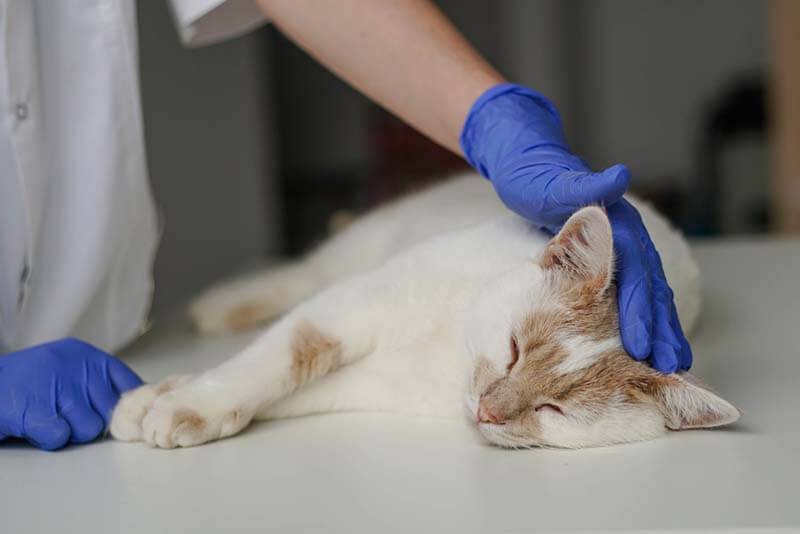
Treating Increased Salivation in Cats
If a cat is drooling, the first thing you need to do is examine it and assess its condition. This will help you understand if an emergency call to the clinic is required.
What can be done at home in some situations before going to the clinic:
The pet was treated with drops on the withers, and now he is salivating. You can wash the cat with dishwashing detergent (it will wash off the sebum, in which the active substance of the drops accumulates).
The cat has access to plants such as dieffenbachia, calla lilies, sansevieria (mother-in-law’s tongue), and she could chew them. You need to gently rinse the cat’s mouth and give it a drink of milk.
The cat could come into contact with household chemicals. Rinse the cat’s mouth, and if it gets dirty in the product, bathe it entirely. Give inside sorbents: Smecta, Enterosgel.
A seizure cannot be stopped at home. You don’t have to put anything in your cat’s mouth! It is important to put her in a safe place on her side, so that she can’t hit or fall. It is advisable to film the attack on video – this is important information for the doctor.
Since excessive salivation is not a disease, but only a symptom of a pathology, then the therapy of the animal will depend entirely on the diagnosis.
Treatment of dental diseases is often carried out under sedation and includes ultrasonic cleaning of the teeth, extraction of diseased teeth and the appointment of antibacterial agents.
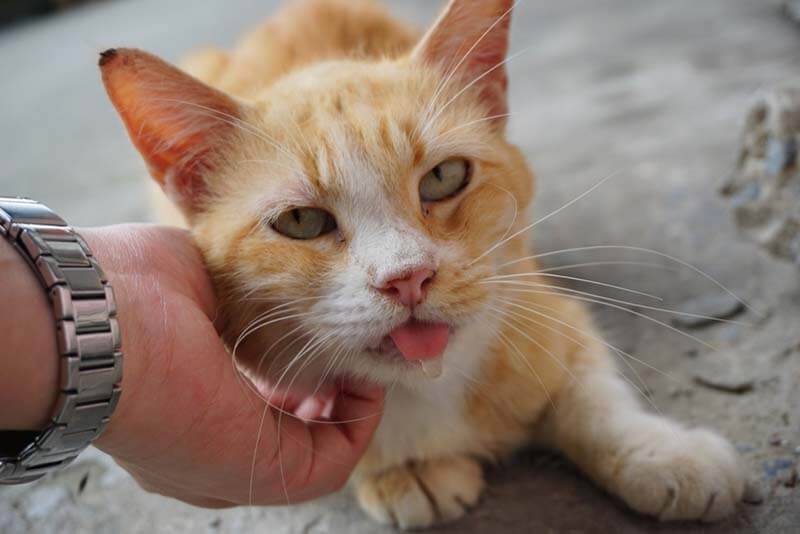
In inflammatory processes, it may be necessary to prescribe antibiotics to prevent the development of bacterial microflora. This is true for calcivirosis, chemical and thermal burns, injuries.
With significant inflammation, the use of painkillers is necessary.
In some situations (trauma, neoplasia, foreign bodies), surgical intervention is required.
Tumors also require cytological or histological examination. It will help determine the type of neoplasia (i.e. tumor) and its degree of malignancy.
With intoxication, liver diseases, pathologies leading to nausea, an integrated approach is needed, including fluid replenishment, the use of antiemetics, vitamins, choleretic, and sometimes antibacterial drugs. In case of a severe general condition, the animal requires stationary observation.
Pulmonary edema is a dangerous condition that requires round-the-clock monitoring and oxygen support until the patient is stabilized. Treatment will depend on the cause of the swelling.
For neurological conditions, treatment may include anticonvulsant therapy, antibiotics, steroids, and even surgery.
Behavioral features do not need to be corrected, this is an individual moment, but to reduce stress levels, for example, it is useful to use sedatives.
If the kitten is drooling
The reasons why a kitten drools are exactly the same as in adult cats, but there are a number of features:
Kittens are more susceptible to viral diseases and endure them more severely;
They are much less likely to have neoplasia, severe diseases of the hepatobiliary system;
Dental problems in kittens are also possible, such as juvenile gingivitis;
Increased salivation is normal against the background of a change of teeth.
Disease Prevention
Prevention of hypersalivation will include the creation of optimal and safe living conditions for the pet.
Timely vaccination will protect him from viral diseases.
Preventing free access to the street will also be an excellent preventive measure.
Regular preventive dental care (cleaning) is essential.
Do not allow a cat to house plants. Avoid all bones in your diet.
Protect your cat from falls from heights and domestic injuries.
Keep needles, fishhooks, paper clips, and other dangerous items out of reach.
Keep your cat away from household chemicals and other toxins.
Use medicines strictly according to the instructions: for example, do not lick off topical products.
Contact your veterinarian for a check-up in a timely manner, conduct regular preventive examinations for elderly animals and animals with chronic diseases.

Excessive salivation in cats is the main thing
The reason that the cat is drooling can be various diseases, for example, dental problems and inflammatory processes in the mouth. Diagnoses can be different: gingivitis, gingivostomatitis, calcivirosis, burns, erosion, tumors, etc. Also, saliva flows with intoxication, liver diseases, nausea, foreign bodies and injuries in the oral cavity, neurological diseases.
In addition to the disease, increased salivation can be caused by: a bitter or unpleasant taste, the sight and smell of attractive food, as well as an individual reaction to stress or pleasure.
The combination of drooling with heavy, rapid breathing is a reason to immediately visit a veterinarian, as this may be a symptom of pulmonary edema.
When eating indoor plants, contact with household chemicals, you can give your pet first aid: rinse the mouth well with plenty of water, if necessary, completely bathe the cat, give sorbents inside: Enterosgel, Smektu.
Treatment of hypersalivation will depend on what kind of pathology led to it. In case of dental problems, sanitation of the oral cavity, treatment or removal of affected teeth is needed. With nausea, intoxication, liver disease and neurological diseases, treatment is aimed at eliminating the primary cause of the disease.
If some disease has become the cause of salivation, other symptoms are also observed: fever, loss of appetite or refusal to feed, vomiting, depression, etc.
Prevention of salivation is aimed at preventing the main and most common causes: regular dental care, vaccination, avoidance of contact with house plants and household chemicals, toxins, etc.
Answers to frequently asked questions
Sources:
Edited by Gary D. Norsworthy. The feline patient, fifth edition, (Cat patient, fifth edition), 2018
Chandler E. A., Gaskell R. M., Gaskell K. J. Diseases of cats, 2011
S. Tutt, D. Deeprose, D. Crosley. Dentistry for dogs and cats, 2015
Poisonous Plants. Poisonous plants // Source: www.aspca.org



